The Data to Develop (D2D) hackathon, organized under the PoliRuralPlus Mobilise Call, brought together municipal experts, planners, IT specialists, and researchers from across the Vidzeme Planning Region (VPR) to co-create a new prototype framework for regional development monitoring. In addition to this, one of the central tasks was to evaluate the PoliRuralPlus AI tools and to smartly utilize other widely available AI tools to support the same goal, testing their potential for integration into regional data analysis and decision-making processes. The initiative aimed to address two critical challenges faced by the region: the lack of a unified data structure across municipalities and the limited analytical capacity to interpret complex development data.
A Two-Phase Collaborative Methodology
The D2D hackathon was carefully structured into two complementary phases—an online preparation stage and a full-day in-person hackathon—followed by post-event integration work with Vidzeme Planning Region experts. This structure ensured both theoretical understanding and practical application, with continuous participant engagement between phases.
Phase 1: Online Preparation and Challenge Framing
The first phase was conducted via Microsoft Teams, enabling broad participation from municipal and regional representatives. Over 50 participants representing 15+ stakeholder groups attended, including specialists from environmental, social, economic, mobility, housing, and innovation sectors.
The session included:
- Expert lectures on designing evaluation frameworks and data structuring principles.
- Introduction to AI tools and the PoliRuralPlus knowledge ecosystem.
- Team formation by thematic area, allowing domain experts to focus on real regional challenges such as housing accessibility, education, energy, and mobility.
- Field reflection tasks (“homework”): Each participant analyzed how their municipality currently collects and reports data, identifying missing datasets and inconsistencies.
This homework phase proved one of the strongest methodological elements, as it encouraged participants to reconnect their organizational reality with regional development goals. The reflection period between phases (approximately two weeks) allowed participants to gather concrete insights and examples for hands-on work in the second phase.
Phase 2: In-Person Hackathon in Smiltene
Held in Smiltene—geographically central to the region—the full-day event emphasized practical, team-based work. The environment fostered intensive co-creation, supported by mentors and experts in data analytics, AI tools, and strategic planning.
The program combined:
- A recap of Phase 1 findings and an expert introduction to AI-based analysis.
- Team workshops developing sector-specific evaluation frameworks aligned with the Vidzeme Development Programme 2022–2027.
- Hands-on testing of PoliRuralPlus tools, such as:
- Jackdaw – AI chat agent for map-based regional analysis.
- MAATool – Multi-Actor Approach collaboration platform for stakeholder engagement.
- Advisor – an AI-based tool supporting indicator design and interpretation.
Teams worked on indicator passports, defining metadata, data sources, and visual structures for assessing regional performance. They explored how AI could automate insight generation from datasets and enhance data comparability across municipalities.
The co-creation worksheets—specifically designed for the event—guided each team from problem definition to data structure design and indicator validation. These structured templates helped maintain focus, making complex analytical processes accessible even to participants with limited prior experience in data modeling.
Cross-Sectoral Cooperation and Expert Diversity
The hackathon succeeded in bringing together professionals from varied domains:
- Municipal development planners and statisticians,
- Education and social service coordinators,
- Environmental and mobility specialists,
- IT developers and data analysts,
- Researchers and AI consultants,
- Innovation and civic engagement experts.
This diversity ensured that each team integrated both technical and contextual knowledge, producing solutions that balanced analytical precision with social relevance.
The Role of Vidzeme Planning Region
Collaboration with Vidzeme Planning Region (VPR) was pivotal throughout all stages. As a co-organizer and end-user, VPR specialists helped align the hackathon goals with the region’s strategic monitoring needs. They provided datasets, clarified methodological expectations, and later participated in evaluating the results.
The partnership worked exceptionally well: VPR’s involvement ensured institutional relevance, while the organizers—NovoFutura and innovation expert Dr. Vita Brakovska—ensured creative methodology and facilitation. Together they established a strong bridge between strategic governance and citizen-driven innovation.
Evaluation and Outcomes
Methodological strengths:
- The hybrid two-phase structure allowed for reflection, learning, and practical application.
- The homework stage successfully deepened understanding and contextualized AI use.
- MS Teams provided an efficient collaborative platform for phase one, supporting screen sharing, document co-editing, and group discussions.
- In-person collaboration in phase two enhanced creativity, trust, and cross-sector engagement.
Challenges identified:
- Some participants had limited data literacy, which slowed early progress.
- AI tools such as Jackdaw required further localization and data integration for full effectiveness.
Despite these challenges, the teams delivered tangible outputs: conceptual framework prototypes containing indicator sets, metadata structures, and visual models for comparing regional development performance. The results were compiled into a joint Regional Evaluation Framework draft, submitted to Vidzeme Planning Region for further refinement.
Legacy and Impact
The D2D hackathon demonstrated how AI-assisted co-creation can support public sector innovation. By merging data analytics, local knowledge, and participatory design, it laid the groundwork for an interoperable and adaptive regional indicator system.
Beyond the technical results, participants reported improved understanding of:
- How data supports strategic decision-making.
- How AI tools can facilitate faster and more transparent evaluations.
- How inter-municipal collaboration can improve data comparability.
The event also produced a replicable methodology that can serve as a model for other PoliRuralPlus pilot regions.
Conclusion,
The Data to Develop hackathon successfully transformed regional development evaluation from a fragmented, manual process into a collaborative, AI-augmented design challenge. Its success stemmed from the balanced integration of digital tools, methodological structure, and human expertise — a model of how European regions can embrace data-driven innovation to build more sustainable futures.



Existing Comments